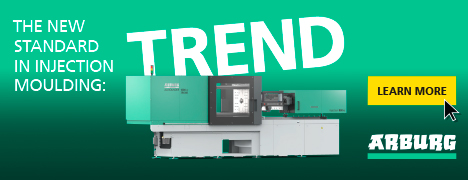|
Recostar iV+: PET-Recycling for reuse with food-contact
Ing. Elfriede Hell, MBA, Starlinger & Co. Ges.m.b.H.
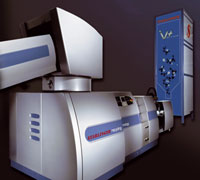 In anticipation of the ever-increasing use of PET, the Austrian company Starlinger & Co. Ges.m.b.H. has developed the new concept Recostar PET iV+. PET waste, both washed post-consumer bottle flakes and pre-form or bottle flakes from in-house or post-industrial sources, is transformed into amorphous pellets. In combination with a solid state polycondensator (SSP), crystalline re-granulate with virgin resin like characteristics (e.g. IV, AA level) are produced. Already in June 2004 the American FDA issued a non-objection letter for the complete Recostar PET iV+ process allowing the re-use of pellets from this system for food-contact. In anticipation of the ever-increasing use of PET, the Austrian company Starlinger & Co. Ges.m.b.H. has developed the new concept Recostar PET iV+. PET waste, both washed post-consumer bottle flakes and pre-form or bottle flakes from in-house or post-industrial sources, is transformed into amorphous pellets. In combination with a solid state polycondensator (SSP), crystalline re-granulate with virgin resin like characteristics (e.g. IV, AA level) are produced. Already in June 2004 the American FDA issued a non-objection letter for the complete Recostar PET iV+ process allowing the re-use of pellets from this system for food-contact.
Extrusion process
The pre-sized material is fed from the crystalliser / dryer into the directly attached extruder which uses the residual heat of the previous drying station. Volatile contaminations as well as monomers are extracted by a degassing unit with high-vacuum execution. Solid contamination is filtered out by a double-piston back-flushing screen changer (DPB). Two pelletising systems are available for PET: the conventional strand pelletising and the newly developed under-water pelletising (UWG).
Solid state polycondensation process (SSP)
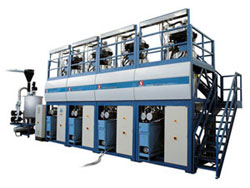 After pelletising the material is immediately transported to a crystalliser using the residual heat where the pellets are heated further by means of hot air and partially crystallized. Using the vacuum in the pre-heater (on top of the SSP reactor), batches are transported into the pre-heater. Under high vacuum the material is further heated. After reaching the reaction temperature the material drops via a sluice into the reactor vessel. The vacuum in the reactor remains unaffected.
After pelletising the material is immediately transported to a crystalliser using the residual heat where the pellets are heated further by means of hot air and partially crystallized. Using the vacuum in the pre-heater (on top of the SSP reactor), batches are transported into the pre-heater. Under high vacuum the material is further heated. After reaching the reaction temperature the material drops via a sluice into the reactor vessel. The vacuum in the reactor remains unaffected.
In the reactor vessel the batch of pellets from the pre-heater are stored for an adjustable reaction time under the conditions of heat and vacuum. Those three factors (temperature, time, vacuum) allow the re-linking of the chains - polycondensation takes place. The required IV increase is controlled by the adjustable residence time. In the optional cooling chamber each batch of pellets is cooled down under vacuum conditions.
FDA Non-objection letter - PET containers
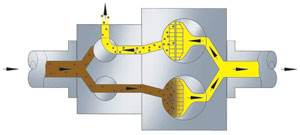 For the FDA non objection letter a challenge test has been performed. PET flakes were contaminated with 5 different chemicals and then stored for 4 weeks under 40 °C. This contaminated flakes were processed with 100 % (that is unmixed with clean flakes) on the Recostar iV+. In the final pellets the concentration of the 5 contaminants were measured again.
For the FDA non objection letter a challenge test has been performed. PET flakes were contaminated with 5 different chemicals and then stored for 4 weeks under 40 °C. This contaminated flakes were processed with 100 % (that is unmixed with clean flakes) on the Recostar iV+. In the final pellets the concentration of the 5 contaminants were measured again.
The result was that the Recostar iV+ system has a cleansing efficiency even with 100% percent contaminated material. This is thanks to a defined residence time in the SSP reactor under optimal temperature and under vacuum conditions. Finally the migration of the contamination into food was mathematically modelled with the result that even on 100% contaminated material the allowed levels on contamination were less than a third.
Acedaldehyd < 1ppm
Thanks to the cleansing efficiency of the SSP reactor after the extrusion, the AA level of the pre-crystallized pellets is also reduced to less than 1 ppm. Thus the material has also an Acetaldehyde level like virgin materials, which is especially important for water and CSD bottles.
Recostar iV+, adjustable increase of iV
Due to the SSP process and an integrated mixing of the pellets before and after the SSP reactor, very constant IV increases of the pellets can be reached, even with variations in the incoming flakes before the extruder. Thanks to the adjustable time in the reactor the IV can be adjusted to the requirements of the planned application.
Applications
Besides the described Bottle-to-Bottle applications, each for post consumer and in-house materials, the Starlinger PET iV+ process is already used for different other PET applications.
One of the uses of bottle flakes after recycling is the production of PET sheet (up to 100 % re-granulate used), both for food and non-food contact. This film has excellent properties for thermoforming.
Other applications for IV increased materials are non-woven or fibres made of PET. In-house or post-industrial materials are transformed into melt-filtrated and IV-increased R-PET pellets. Besides the IV increase, also the decontamination of the pellets of the spin finishes and oil in the reactor increases the amount of the recycled material which can be used in the production process again.
With the Recostar iV+ process even an increase for high tenacity strapping applications with an IV of 0.95 are possible.
Process and technical advantages
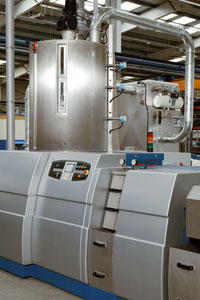 Both, pre-drying of the PET-flakes and mild screw geometry result in a minimal IV loss in the extruder. The design of extruder, adapters, optimised channel geometry of screen changer and pelletising units emphasized as little deviation as possible in order to avoid dead corners, otherwise long residence time would lead to thermally damaged material and yellowing. The high-vacuum execution of the vacuum reduces the IV degradation and purifies the melt.
Both, pre-drying of the PET-flakes and mild screw geometry result in a minimal IV loss in the extruder. The design of extruder, adapters, optimised channel geometry of screen changer and pelletising units emphasized as little deviation as possible in order to avoid dead corners, otherwise long residence time would lead to thermally damaged material and yellowing. The high-vacuum execution of the vacuum reduces the IV degradation and purifies the melt.
Advantages of the optional under-water pelletising are simple start-up procedure with integrated start-up valve, less cooling water required, minimized operator intervention and compact design.
The conventional strand-pelletising system is part of the standard equipment. The optional step 'crystallization' requires partial crystallized material. Consequently a special water-bath has been designed. This allows the strands to cool more slowly and generate surface crystallization.
The whole system - that is extrusion and in-line SSP - is continuous respectively semi-continuous. This allows using the residual heat from the previous step resulting in energy savings. Both crystalliser and SSP reactor work on the FIFO principle (first-in / first-out). This ensures that every particle is transformed under the same process-time and -parameter. It is paramount to ensure the adjusted residence time for each particle.
The modular system of the SSP enhances flexibility. It enables the user to choose the number of SSP units according to required residence time (and consequently IV increase). It also allows producing amorphous, crystalline and IV-enhanced pellets according to actual needs.
Available machine sizes
The Recostar PET-Series is available in five different sizes and covers an output of 180 - 1.200 kg/h with variable numbers of SSP units, depending on the final application, IV and food-contact requirements.
Starlinger & Co. Gesellschaft m.b.H.
Sonnenuhrgasse 4
1060 Wien, Austria
Phone: +43 1 59955-241
Fax: +43 1 59955-180
Email: sales.he@starlinger.com
Internet: www.starlinger.com |  back to the list
back to the list back to top
back to top
 In anticipation of the ever-increasing use of PET, the Austrian company Starlinger & Co. Ges.m.b.H. has developed the new concept Recostar PET iV+. PET waste, both washed post-consumer bottle flakes and pre-form or bottle flakes from in-house or post-industrial sources, is transformed into amorphous pellets. In combination with a solid state polycondensator (SSP), crystalline re-granulate with virgin resin like characteristics (e.g. IV, AA level) are produced. Already in June 2004 the American FDA issued a non-objection letter for the complete Recostar PET iV+ process allowing the re-use of pellets from this system for food-contact.
In anticipation of the ever-increasing use of PET, the Austrian company Starlinger & Co. Ges.m.b.H. has developed the new concept Recostar PET iV+. PET waste, both washed post-consumer bottle flakes and pre-form or bottle flakes from in-house or post-industrial sources, is transformed into amorphous pellets. In combination with a solid state polycondensator (SSP), crystalline re-granulate with virgin resin like characteristics (e.g. IV, AA level) are produced. Already in June 2004 the American FDA issued a non-objection letter for the complete Recostar PET iV+ process allowing the re-use of pellets from this system for food-contact. After pelletising the material is immediately transported to a crystalliser using the residual heat where the pellets are heated further by means of hot air and partially crystallized. Using the vacuum in the pre-heater (on top of the SSP reactor), batches are transported into the pre-heater. Under high vacuum the material is further heated. After reaching the reaction temperature the material drops via a sluice into the reactor vessel. The vacuum in the reactor remains unaffected.
After pelletising the material is immediately transported to a crystalliser using the residual heat where the pellets are heated further by means of hot air and partially crystallized. Using the vacuum in the pre-heater (on top of the SSP reactor), batches are transported into the pre-heater. Under high vacuum the material is further heated. After reaching the reaction temperature the material drops via a sluice into the reactor vessel. The vacuum in the reactor remains unaffected.
 For the FDA non objection letter a challenge test has been performed. PET flakes were contaminated with 5 different chemicals and then stored for 4 weeks under 40 °C. This contaminated flakes were processed with 100 % (that is unmixed with clean flakes) on the Recostar iV+. In the final pellets the concentration of the 5 contaminants were measured again.
For the FDA non objection letter a challenge test has been performed. PET flakes were contaminated with 5 different chemicals and then stored for 4 weeks under 40 °C. This contaminated flakes were processed with 100 % (that is unmixed with clean flakes) on the Recostar iV+. In the final pellets the concentration of the 5 contaminants were measured again.
 Both, pre-drying of the PET-flakes and mild screw geometry result in a minimal IV loss in the extruder. The design of extruder, adapters, optimised channel geometry of screen changer and pelletising units emphasized as little deviation as possible in order to avoid dead corners, otherwise long residence time would lead to thermally damaged material and yellowing. The high-vacuum execution of the vacuum reduces the IV degradation and purifies the melt.
Both, pre-drying of the PET-flakes and mild screw geometry result in a minimal IV loss in the extruder. The design of extruder, adapters, optimised channel geometry of screen changer and pelletising units emphasized as little deviation as possible in order to avoid dead corners, otherwise long residence time would lead to thermally damaged material and yellowing. The high-vacuum execution of the vacuum reduces the IV degradation and purifies the melt.
